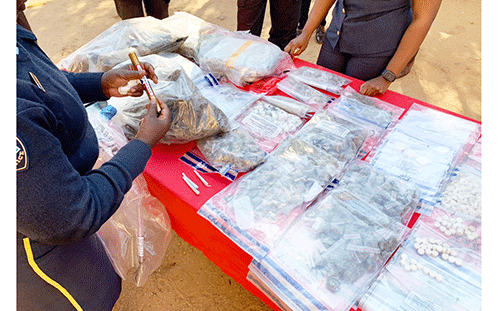MARIENTAL – A troubling epidemic of drug abuse is casting a shadow over the vibrant communities nestled in the southern region of Hardap.
This abuse is wreaking havoc, transforming communities into battlegrounds of addiction and crime.
While this area is renowned for its natural beauty and agricultural potential, it is increasingly grappling with the harsh realities of substance abuse.
This threatens the moral fabric of the community.
Reports indicate that drug trafficking and consumption have surged, particularly in towns like Rehoboth, where local authorities are sounding the alarm about rising crime rates linked to these illicit activities.
The pervasive influence of drugs not only fuels crime, but also implicates vulnerable populations, including schoolchildren, in a cycle of violence and despair.
When this publication visited the region this month, most if not all authorities were concerned about the abuse of drugs, especially among the youth.
Drugs statistics
Regional governor Solomon April reported a 6.3% increase in crime in the region in the 2023/24 financial year, compared to 2022/23.
The predominant offences include assault with intent to cause grievous bodily harm
and domestic-related crimes such as rape, various forms of theft, housebreaking and stock theft.
During his state of the region address in April, the governor observed that the rise in crime is attributed to several factors, including alcohol and drug abuse, poverty due to unemployment, and greed.
On drug-related offences, he said a total of 272 cases related to possession or dealing in dependency-producing substances were recorded.
“Specifically, 154 cases of possession or dealing with dangerous drugs were identified in Rehoboth and Mariental. There were 110 arrests, comprising 94 male adults, 15 females and 1 juvenile female at the time,” he pointed out.
The authorities confiscated significant quantities of drugs for the year under
review, including 2 571 kg of cannabis, valued at about N$25 000; 8 373 kg of skunk, valued at N$418 000; 583 full Mandrax tablets, valued at close to N$70 000; and 100 units of cocaine, valued at N$10 000.
The total value of the drugs seized amounted to over half-a-million for the past year. Deputy Commissioner John Mwatongwe, head of the regional crime investigations’ division, has outlined the police’s efforts to combat drug abuse in the region.
He stated that “regular, open communication and community outreach programmes build trust and transparency”.
Mwatongwe highlighted the importance of community policing strategies, where officers work closely with residents to address local concerns, and co-create solutions.
This collaborative approach fosters a sense of shared responsibility and cooperation within the community.
To further engage the public, he outlined organising community events such as peace marches and local sporting events, where police officials can participate.
“Proactively involving the community in policing is also a key activity at the leadership and community level,” he added, referring to forums and meetings which encourage participation in community functions.
He acknowledged a problem linked to high-profile incidents of misconduct by uniformed officers, stating that “public trust in the police force has been declining in recent years”.
To address this issue, he stressed the necessity for the Namibian Police to keep up with technology to stay ahead of criminals.
A senior nurse at the Stampriet clinic conveyed that drug abuse at the town is adding to their challenges, as many individuals are experiencing malnutrition by spending their money on drugs rather than food.
The nurse made these remarks during a familiarisation visit this month regarding the malnutrition situation in Namibia with the Parliamentary Standing Committee on Gender Equality, Social Development and Family Affairs.
“We are experiencing malnourished adults because they just spend money on drugs. Even teenagers now are falling pregnant due to this abuse,” said the nurse.
She pointed out that children also suffer from malnutrition because their parents are unable to care for them adequately due to drug abuse.
Meanwhile, the youth in the area are bearing the brunt of this crisis, with many turning to drugs as an escape from their harsh realities like unemployment.
Statistics presented at the clinic serving a population of about 5 000 indicated that from January to September 2024, there were 34 reported cases of malnutrition among children aged 0 to 5 years, one case in the 5 to 17 age group, and 64 cases for individuals aged 18 and older.
-mndjavera@nepc.com.na


